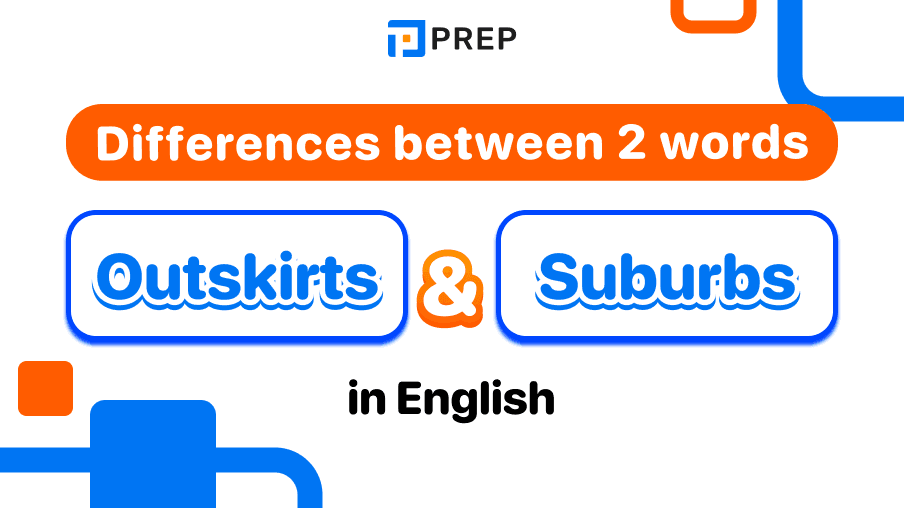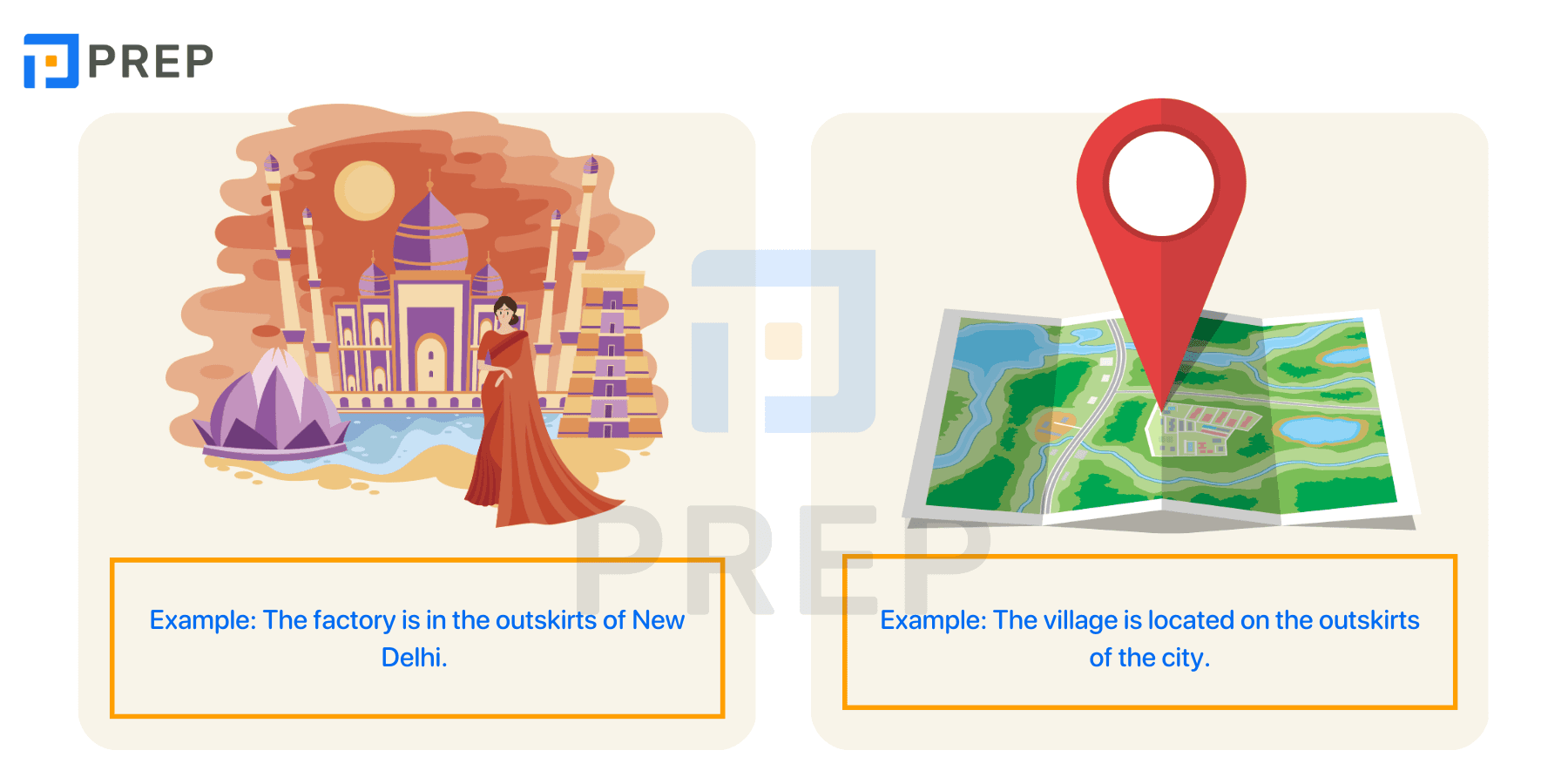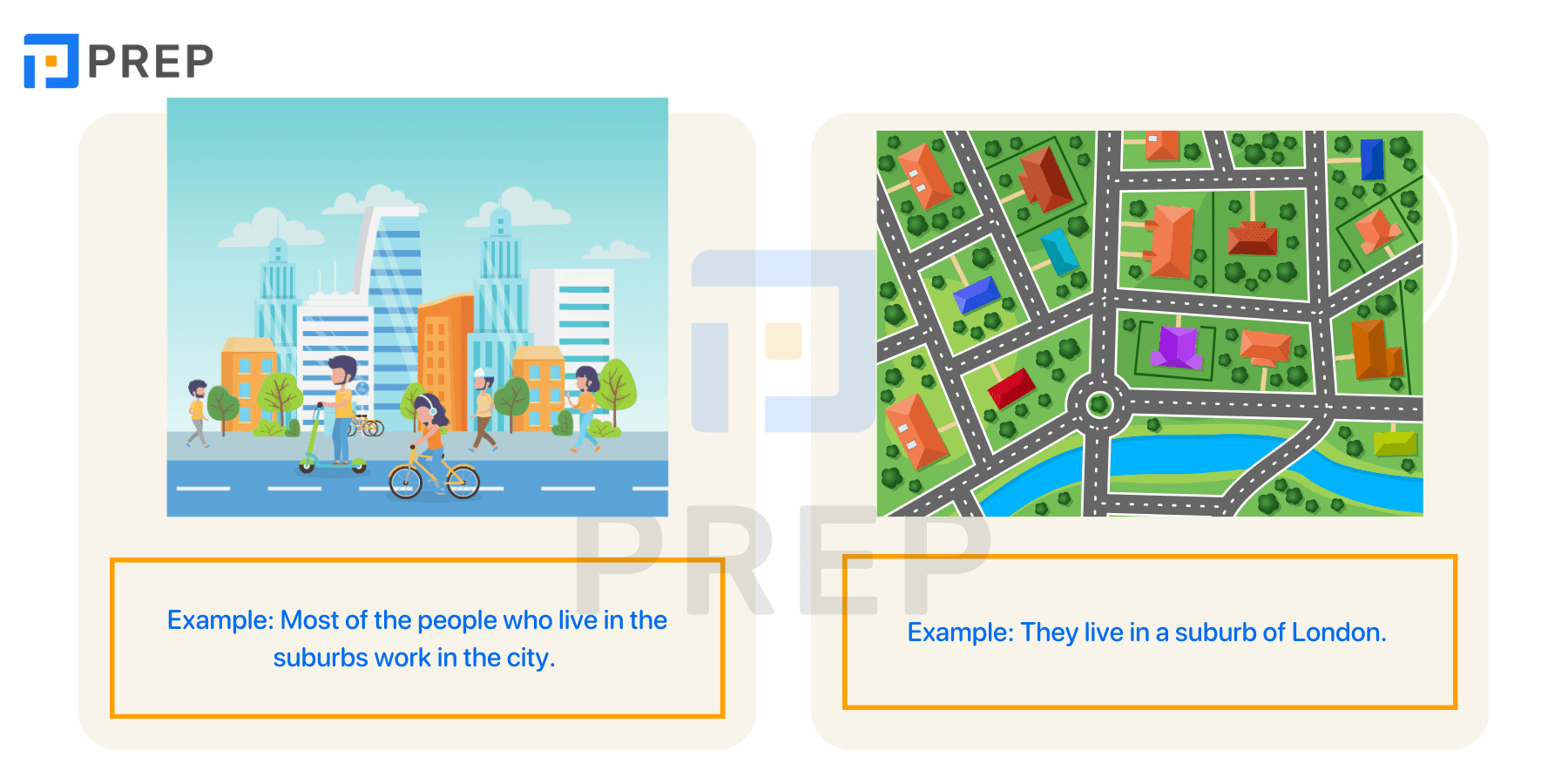Outskirts vs Suburbs: Meaning, Use, and Examples
The terms “outskirts” and “suburbs” often confuse English learners. This article explains their meanings, key differences, and usage in everyday and academic contexts. You will also find common phrases and IELTS examples to practice and improve your vocabulary.

I. What Does “Outskirts and Suburbs” Mean?
When talking about cities in English, you’ll often hear the words “outskirts” and “suburbs”. Both refer to areas outside or surrounding the central part of a city, but they are not exactly the same.
- “Outskirts” usually refers to the outer edges or borders of a city. These areas are less developed and are often closer to rural or industrial zones. For example:
“He lives on the outskirts of Tokyo, where housing is more affordable.”

- “Suburbs”, on the other hand, refers to residential areas just outside the city center. Suburbs are typically quieter, family-friendly, and more organized than central city areas. For example:
“Many people prefer living in the suburbs because of lower rent and more space.”

In short:
- Outskirts = outermost urban edge (often less developed)
- Suburbs = near-urban residential area (often planned and residential)
They are often used interchangeably in everyday speech, but in academic writing or IELTS/TOEIC exams, understanding their nuance will help you write and speak more clearly.
1. Key Differences Between Outskirts and Suburbs
Although “outskirts” and “suburbs” both refer to areas outside the city center, they differ in meaning, usage, and context. Understanding these differences is especially useful in exam writing and speaking tasks where vocabulary precision matters.
Overview Comparison:
|
Feature |
Outskirts |
Suburbs |
|
Definition |
Outermost edge or boundary of a city |
Residential area outside the city center |
|
Development Level |
Less developed, may include empty land or factories |
Well-developed, mainly residential areas |
|
Common Function |
Industrial, rural, undeveloped zones |
Housing, schools, parks, daily life activities |
|
Typical Usage |
“on the outskirts of...” |
“in the suburbs” |
|
Example |
"We drove past some farms on the outskirts of town." |
"They just moved to the suburbs for their kids." |
Quick Tips:
- Use “suburbs” when describing family life, housing, or neighborhoods.
- Use “outskirts” when referring to far edges of a city, often less urbanized.
- In the IELTS Speaking test, using the correct one shows better lexical resource.
Mastering this subtle distinction will help improve both your vocabulary accuracy and overall fluency.
2. Outskirts and Suburbs in Different Contexts
While “outskirts” and “suburbs” may appear similar, their meaning can shift depending on the context in which they are used. To use these terms accurately in English, especially in academic or exam settings, it’s important to understand how they function across different situations.
Urban Planning and Development
In urban planning, ‘suburbs’ refer to structured residential zones — similar to city development terms you’ll find in IELTS vocabulary by topics. “Outskirts,” in contrast, are commonly zones beyond that planning reach, sometimes underdeveloped, sparse, or semi-rural.
Cultural and Social Perceptions
In many countries, suburbs are associated with middle-class living, quiet neighborhoods, and family life. They may carry positive connotations like safety or space. On the other hand, outskirts may imply remoteness or lack of convenience, though this varies between countries and cities.
Academic and Exam Contexts (IELTS, TOEIC, APTIS)
In English language exams, particularly IELTS Speaking or Writing, using these words appropriately can show strong lexical precision. For example, describing life in the suburbs may reflect a more structured, livable community, whereas mentioning the outskirts could suggest distance, underdevelopment, or longer commute times.
Understanding these contextual nuances allows you not only to choose the right word but also to demonstrate clearer, more natural English use across a range of topics.
II. Common English Phrases with Outskirts and Suburbs
Building strong vocabulary means not only understanding a word’s definition, but also knowing how it commonly appears in real sentences. Below are useful collocations (word combinations) with “outskirts” and “suburbs” that often show up in speaking, writing, and reading contexts.
Common Collocations with “Outskirts”
|
Collocation |
Meaning |
Example Sentence |
|
on the outskirts of |
at the edge or boundary of a city |
She lives on the outskirts of Bangkok, where rent is lower. |
|
industrial outskirts |
factory or manufacturing zone near a city |
The industrial outskirts are filled with warehouses. |
|
remote outskirts |
far from city center or services |
Emergency access is limited in the remote outskirts. |
|
located on the outskirts |
positioned on the edge |
The airport is located on the outskirts of the city. |
Common Collocations with “Outskirts”
|
Collocation |
Meaning |
Example Sentence |
|
on the outskirts of |
at the edge or boundary of a city |
She lives on the outskirts of Bangkok, where rent is lower. |
|
industrial outskirts |
factory or manufacturing zone near a city |
The industrial outskirts are filled with warehouses. |
|
remote outskirts |
far from city center or services |
Emergency access is limited in the remote outskirts. |
|
located on the outskirts |
positioned on the edge |
The airport is located on the outskirts of the city. |
Practice Sentences
Try to complete or adapt these sentences using what you've learned:
- My uncle’s house is on the ____________ of town, right next to the highway.
- They decided to move to the ____________ for a bigger home.
- Public transport is limited in the remote ____________.
- I enjoy the suburban ____________ because it's quieter than the city.
Practicing these combinations in context will help you sound more fluent and natural. For broader lexical improvement, explore our IELTS Vocabulary Booster guide.
III. Applications in Exams and Academic Writing
Understanding how to use “outskirts” and “suburbs” properly can help you perform better in English proficiency exams and formal writing. These terms are especially relevant in topics related to urban life, housing, transportation, and city development—common themes in IELTS, APTIS, and TOEIC.
Speaking Contexts (IELTS, APTIS Speaking)
When describing where you live or expressing opinions about urban vs. suburban life, using precise vocabulary like “suburbs” and “outskirts” shows strong lexical awareness. Sample speaking questions where you can use these terms:
- Do you live in the city or in the suburbs?
- What are some advantages of living on the outskirts of a city?
- Would you prefer to live in the suburbs or near downtown?
Example answer:
"I currently live in a quiet suburb just outside the city. It’s peaceful, and I enjoy having more space compared to central areas."
Writing Contexts (IELTS Writing Task 1 & 2, Reports and Essays)
- In Task 1 of the IELTS exam, you may need to describe maps showing urban expansion over time. Knowing the difference between suburbs and outskirts allows you to describe the transformation of a city more accurately.
- In Task 2, when discussing infrastructure, lifestyle, or housing policies, these terms often support your ideas with clarity and variety.
Example sentence (Writing Task 2 essay):
“Urban sprawl has led to rapid development of the suburbs, while the outskirts remain relatively underdeveloped.”
Academic Writing and Reports
If you're writing essays or reports on social studies, geography, or urban planning, “suburbs” and “outskirts” can help articulate distinctions between residential patterns or socioeconomic environments. Use them carefully to reflect tone and precision in formal contexts.
Tips for Exam Use:
- Use “suburbs” for structured residential areas with community infrastructure.
- Use “outskirts” for outer zones not fully integrated into urban services.
- Watch for collocations (e.g., “live in the suburbs”, “edge of the city”, “on the outskirts”) to improve fluency and natural tone.
To further expand your lexical resource, check out Enrich your IELTS vocabulary for high-band examples.
Mastering the difference between “outskirts” and “suburbs” goes beyond knowing two similar vocabulary words—it’s about refining the way you describe places and environments in clear, natural English. Whether you're discussing housing preferences, city life, or urban planning, these terms help express ideas with precision and depth.
By understanding their definitions, typical usage, and how they appear in exams and real-life contexts, you're not only improving your vocabulary—you’re building confidence for both academic writing and fluent communication. Ready to bring these words into your next conversation or essay?

Hi I'm Chloe, and I am currently serving as an Product Content Administrator at Prep Education. With over five years of experience in independent online IELTS study and exam preparation, I am confident in my ability to support learners in achieving their highest possible scores.
Comment
Premium content
View allPersonalized roadmap
Most read












